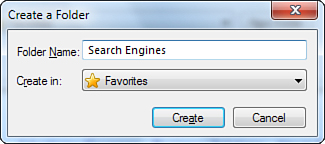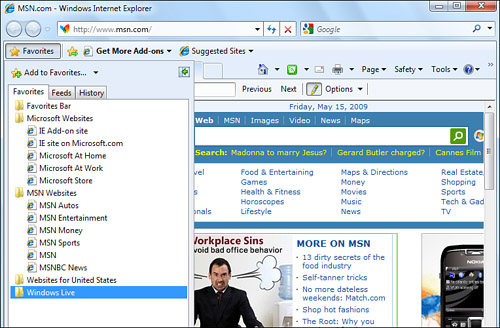Browsing with Enhanced Privacy and Security
The
Internet is becoming an increasingly rich connective space where much
personal information is given and sometimes taken. Users aren’t always
aware that when they browse the Internet the websites they visit might
be tracking their browsing habits. IE8 safeguards your personal
browsing information from other people entrusted with access to your
computer and from sites you aren’t aware are attempting to pilfer your
data.
IE8 includes a series of
security and privacy features, one of which is called InPrivate
Browsing. An InPrivate session captures all traces of your personal
browsing activities—including those deemed Not Safe For Work (NSFW)—and
erases those details when you close the browser. All cookies, temporary
Internet files, browsing history, form information, submitted
usernames, and typed passwords simply vanish. To enable InPrivate
Browsing, either click the Safety button in the toolbar and select
InPrivate Browsing or press Ctrl+Shift+P.
New
malware protections such as the SmartScreen antiphishing filter prevent
those most prolific online scams from fooling you into revealing
sensitive information to unauthorized parties. SmartScreen warns you
when you select a site deemed harmful (for example, known to harbor
malware or to be posing as a false front for a financial institution)
with a constantly updated database of bad sources.
InPrivate
Filtering is designed to deter sites from sharing your browsing habits
without your knowledge. InPrivate Filtering enables selective site
blockage so that the places you visit cannot harvest your information
and pass it along to third parties. A small lock icon with an arrow (at
the lower right of the browser window; see Figure 5)
indicates that InPrivate Filtering is active. To enable InPrivate
Filtering, either click the Safety button in the toolbar and select
InPrivate Filtering or press Ctrl+Shift+F. You can also access
InPrivate Filtering settings from the Safety menu. If InPrivate
Filtering blocks from display third-party data that you need, you can
specify custom feature settings as a workaround.
Microsoft
also includes additional safety features. IE8 blocks common forms of
cross-site scripting attacks and provides better protection against
malicious ActiveX controls. It also attempts to prevent click-jacking,
which is when an attacker places invisible buttons above or below
legitimate buttons, thereby duping unsuspecting users into activating
malicious code or revealing private information. And unlike previous
browsers, IE8 offers the Delete Browsing History screen so you have
granular control over cookies and temporary Internet file deletions. To
access IE8’s improved browsing deletion tools, click the Safety button
and choose Delete Browsing History or simply press Ctrl+Shift+Del. If
you check the box titled Preserve Favorites Website Data, no
information related to your bookmarked sites will be erased.
Adding Sites to Your Favorites
It’s
very inefficient (not to mention annoying) to type the URL in the
Address box every time you want to access your favorite sites. It’s
also difficult, if not impossible, to remember all your favorites.
Fortunately, IE8 lets you add, save, and categorize your favorites so
you can access them in the Favorites pane, which now entirely replaces
the Links bar (and all related functionality). The Favorites Bar
contains the Favorites button, a quick Add To Favorites button, the
Suggested Sites Web slice, and a Get More Add-Ons Web slice.
The
process of adding a favorite is fairly simple. Your first step is to
browse to the website you want to make one of your favorites. For best
results, open the main or index page of the website first. Now try the
following:
1. | Click
the Add to Favorites button in the Favorites Center on the toolbar (the
side window that appears when you click the Favorites button), and then
click Add to Favorites Bar.
|
2. | In the Add a Favorite dialog box, type the name of the favorite in the Name box, as shown in Figure 7.
You can also change the name so that you will be able to easily
identify the page. Whatever name you enter is shown in your Favorites
list.

|
3. | From
the Create In list, select the folder where you want to save the
favorite. IE8 contains five folders by default: the home (Favorites)
directory, Microsoft websites, MSN Websites, and Windows Bing.
|
4. | If
you want to create a new folder or subfolder within one of the current
folders, click the New Folder button. The Create a Folder window
appears, as shown in Figure 8.

|
5. | Type the folder name in the Folder Name box.
|
6. | From
the Create In list, select the folder where you want to create the new
folder. The default is the home (Favorites) directory.
|
7. | Click Create. The new folder you created appears in the Create In list.
|
8. | Click Add. IE8 adds your favorite to the list.
|
Now that you’ve added a favorite to the list, you can view the favorite by opening the Favorites Center pane. Here’s how:
1. | Click the Favorites button in the toolbar. The Favorites Center pane appears on the left side of the window, as shown in Figure 9. Notice that the Favorites Center pane overlaps the web page you’re viewing.

|
2. | Click the folder that contains the favorite. The favorite appears underneath the folder name.
|
3. | Click the favorite name to open the web page in the right pane.
|
4. | Close the Favorites Center pane by clicking the Favorites button. |